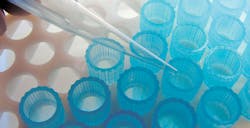Spoiled samples. Unusable product. Risk to patient safety. These are just some of the possible outcomes when sample and product integrity are put at risk through fluctuations in temperature.
Anyone who has worked in a clinical laboratory setting knows the critical importance of temperature monitoring to ensure quality for testing and safety purposes. Inconsistent temperatures can threaten sample integrity, forcing labs to replace any samples and product deemed unusable after being exposed to faulty temperatures and thus leading to increased costs. Having exact and accurate data is at the heart of laboratory work, and precise temperatures need to be monitored and documented at any given time of the day or night.
When laboratories rely on manual temperature monitoring techniques, they can be paying the price in time consumed, increased cost, inconsistent results, and the risk of being cited for non-compliance. Maintaining proper and consistent temperatures, and documenting any corrective actions, are crucial, but extremely time-consuming, and that takes time away from other tasks. Workload and time pressures can make consistency and accuracy a challenge. For that reason, many lab leaders are adopting wireless temperature monitoring systems and are finding that the initial investment in the automated system pays for itself over time.
What is wireless temperature monitoring?
Wireless temperature monitoring systems passively monitor temperatures in key points throughout the laboratory by means of a temperature probe connected to a transmitter. A wireless receiver collects temperature readings from each location and reports the data to a local server or cloud-based network where the data can be stored and analyzed.
One of the most beneficial features that wireless temperature monitoring systems offer is the ability to provide a prompt alert when temperatures fall out of specified ranges. Many systems provide notifications via email, text messaging, or even voice notifications to help ensure the alert is seen and addressed as quickly as possible. In addition, systems may provide an alarm escalation feature, meaning that if the first point of contact does not acknowledge the warning, a second individual can be notified. When an alarm is reacted to, many systems allow users to document any corrective actions that were implemented.
Key information is viewable through the automated documentation feature of any wireless temperature monitoring system. Readings for temperature, humidity, pressure, and air can be collected over time and stored within the system’s corresponding data base. Users can access compiled data and review it through a variety of reports. Reporting features assist in highlighting trends or providing alarm histories. Many systems offer the ability to create custom reports and export them in commonly used formats such as PDF, Excel, or Word.
Compliance considerations
A comprehensive compliance program is not only crucial for monitoring systems in clinical laboratories — it is now a legal requirement. Compliance requires documented verification that systems are installed and functioning according to the manufacturer’s intended use. An appropriate monitoring system should be able to provide the proper IQ/OQ validation assistance and documentation. Thus, a vital feature of any wireless monitoring system is the ability to provide detailed data collecting and report generating capabilities. This also makes audits and healthcare compliance more efficient. The software should be built and based on meeting the FDA 21 CFR Part 11.
Additionally, certifying organizations such as The Joint Commission require laboratory instrumentation to be NIST-certified. There are various NIST-traceable calibration programs available that provide real-time documentation within the software. For labs that already have a compliance program that covers their laboratory temperature monitoring needs, constant review is now required to ensure continued compliance. Specific recalibration intervals depend on a number of factors, but given the frequency, organizations are looking for simplicity of device recalibration (in-situ), along with electronic storage of certificates that can be recalled during inspections, and easy notification of next recalibration events. NIST-traceable products and recalibration services offer a complete solution for applications.
System applications
With numerous suppliers offering similar systems, due diligence must be observed when researching and comparing features during the selection process. When choosing a supplier, lab managers should consider which system is most user-friendly and provides all the necessary reporting capabilities to meet compliance and inspections. Reviewing referrals from vendors and determining what training and after-sales support they offer is also key.
Monitoring both ambient temperature and humidity at each point-of-care work station ensures that testing products stored at ambient is not compromised. And, along with temperature and humidity monitoring in the laboratory, a number of other applications can benefit from an automated, wireless monitoring system. For example, CO2 percent values in incubators are regulated to optimize PH growth conditions for microbiological and tissue growth. The automated monitoring and recording of CO2 values via wireless devices can augment local incubator alarms and provide continuous, real-time CO2 values with the ability to generate a remote alarm 24/7, including times when laboratory personnel are not present.
Air velocity for the hoods, test tube rack adaptors for monitoring temperatures, and power detection devices that indicate a loss of power are also constructive wireless applications. Lab leaders should consider the improvement made in temperature probe technology to take advantage of these offerings. Typical probe setups use a glycol solution to serve as a buffering mechanism for the probe to eliminate air temperature fluctuations and false alarms due to frequent opening and closing of storage devices. A few suppliers offer a liquid glycol alternative and use a solid state simulator with an embedded thermistor with similar thermal buffering characteristics as glycol. The solid simulator eliminates the need for glycol MSDS/SDS sheets and the potential for glycol spills.
Mark Donovan serves as Vice President, Healthcare, for Cooper-Atkins Corporation.

